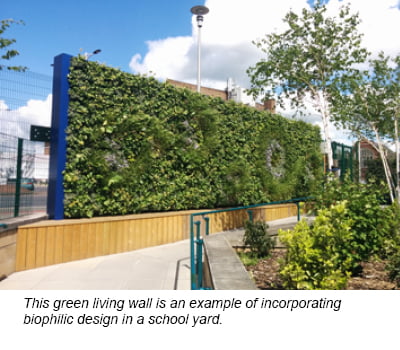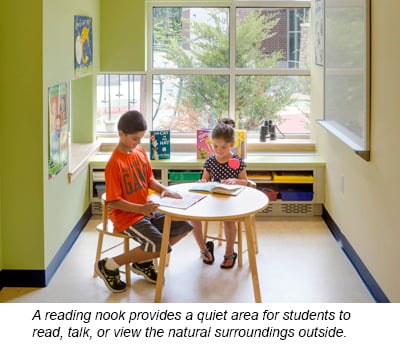Biophilic Design in the Learning Environment
Watching a beautiful sunrise, taking a walk in the woods, listening to the sound of water flowing in a river – there is no doubt that experiencing nature has a positive, often rejuvenating, effect on our lives. Humans intrinsically seek connections to nature, but as Americans spend an increasing amount of time indoors, those connections are being lost. Studies have shown that this separation from nature resulting from spending up to 90% of our time in a primarily unnatural environment is having a negative impact on our physical health, emotional well-being, and cognitive function. Biophilic design seeks to reconnect people to nature in the built environment.
The term biophilia, meaning a love of living things and nature, is largely credited to Harvard biologist E.O. Wilson who popularized the concept in the mid 1980’s. Biophilic design is an extension of that idea, and is one aspect of the larger sustainability movement, with a focus on the human experience in the built environment rather than just energy conservation.
 The late Dr. Stephen Kellert, a professor at Yale University, was a leader in the field of biophilic design and author of several books on the subject. He describes three ways to experience nature in the built environment: direct experience of nature, such as natural light, fresh air, water, and plants; indirect experience of nature, such as use of natural materials, natural geometries, and images of nature; and experience of space and place, using principles such as prospect and refuge, organized complexity, and clear and discernable transitional spaces.
The late Dr. Stephen Kellert, a professor at Yale University, was a leader in the field of biophilic design and author of several books on the subject. He describes three ways to experience nature in the built environment: direct experience of nature, such as natural light, fresh air, water, and plants; indirect experience of nature, such as use of natural materials, natural geometries, and images of nature; and experience of space and place, using principles such as prospect and refuge, organized complexity, and clear and discernable transitional spaces.
Because students spend several hours a day in the classroom, there is an opportunity to use biophilic design to provide that important connection to nature and for students to reap the benefits. Children today spend less time outside and more time looking at a screen than any previous generation. There is even research suggesting that lack of contact with nature has contributed to the rise in ADHD; behavioral disorders such as this are described by Richard Louv in his book, Last Child in the Woods as “nature-deficit disorder”. Classrooms that incorporate elements of biophilic design can have significant benefits, including increased attendance, higher test scores, improved behavior, reduced stress, and increased focus.
 While something as simple as having a few plants in a room can have a positive impact, biophilic design is more immersive, intended to create an environment that provides the same benefits as being in nature. While there are more obvious strategies, such as green roofs, or large windows to bring in abundant natural light and provide access to natural views, there are also more inventive approaches, such as LED lights that adjust their color over the course of the day to mimic the sky. In large, open classrooms, which can feel overwhelming or distracting for some students, huddle spaces or cozy nooks can be provided as a place of refuge. Where access to views of a natural setting aren’t possible, use floor and wall coverings with natural patterns, textures, and colors. Natural materials with tactile surfaces such as wood and stone create a sense of calm. While regular geometric shapes like squares and rectangles are the least expensive to build, they can also lack interest; introducing more natural forms such as a curved path can encourage intellectual stimulation.
While something as simple as having a few plants in a room can have a positive impact, biophilic design is more immersive, intended to create an environment that provides the same benefits as being in nature. While there are more obvious strategies, such as green roofs, or large windows to bring in abundant natural light and provide access to natural views, there are also more inventive approaches, such as LED lights that adjust their color over the course of the day to mimic the sky. In large, open classrooms, which can feel overwhelming or distracting for some students, huddle spaces or cozy nooks can be provided as a place of refuge. Where access to views of a natural setting aren’t possible, use floor and wall coverings with natural patterns, textures, and colors. Natural materials with tactile surfaces such as wood and stone create a sense of calm. While regular geometric shapes like squares and rectangles are the least expensive to build, they can also lack interest; introducing more natural forms such as a curved path can encourage intellectual stimulation.
While biophilic design strategies may change based on the project’s location – there are different opportunities available in a desert environment than in wooded areas, or rural versus urban areas – the end result is the same. Improved student learning rates, enhanced resilience and cooperation, boosts in creativity, and reduced stress and anxiety are just some of the benefits. As Dr. Kellert states in his book, Birthright: People and Nature in the Modern World, “We will never be truly healthy, satisfied, or fulfilled if we live apart and alienated from the environment from which we evolved.”

